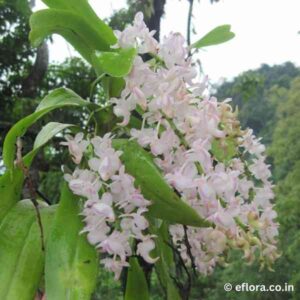Acampe carinata (Keeled Rigid Air Blossom)
Stem branched, 20–40 cm long, 5–8 mm in diam., internodes 2–3 cm long, covered with leafsheaths. Leaves oblong, 6.5–14.0 × 1.3–3.0 cm, apex obtuse, unequally bilobed. Inflorescence leafopposed or axillary, racemose to sub-corymbose; peduncle green, 1.5–3.0 cm long, 3.0–3.5 mm in diam.; rachis 3–4 cm long, 3–4 mm in diam., densely few to many flowered; floral bracts broadly ovate-triangular, 1-2 mm long. Pedicel and ovary, pale yellow 7–8 mm long. Flowers slightly fragrant, opening widely, 1.1–1.3 cm in across; sepals and petals yellow with reddish brown transverse stripes, lip creamy white, slightly spotted with purple-red, spur yellow. Dorsal oblong-elliptic, 5.0–6.5 × 1.8–2.3 mm, apex obtuse; lateral sepal’s falcately-oblong, 5.0–8.0 × 2.0–2.5 mm, apex obtuse. Petals narrowly linear-elliptic, 6–9 × 1.5–2.4 mm, apex obtuse. Lip 8–9 × 2.5–4.5 mm, inconspicuously 3-lobed, divided into epichile and hypochile; hypochile with erect, obscurely triangular sidelobes, around entrance of spur; epichile ovate, 3.5–4.5 × 3–4 mm, margins erose, warty in apical half and papillose in basal half, base with a transverse septum separating it from hypochile; spur straight, conic, 2.5–3.5 mm long, pubescent within. Column 1.8–2.0 mm high. Capsule sub-clavate, 1.8–3.0 × 0.4–0.6 cm, ridged.
Etymology: The genus name Acampe is derived from the Greek word akampos, meaning “rigid” or “stiff,” referring to the tough and wiry stems of the plants in this genus. The specific epithet carinata comes from the Latin word carinatus, meaning “keeled,” referring to the prominent ridge or keel-like structure on lip.






